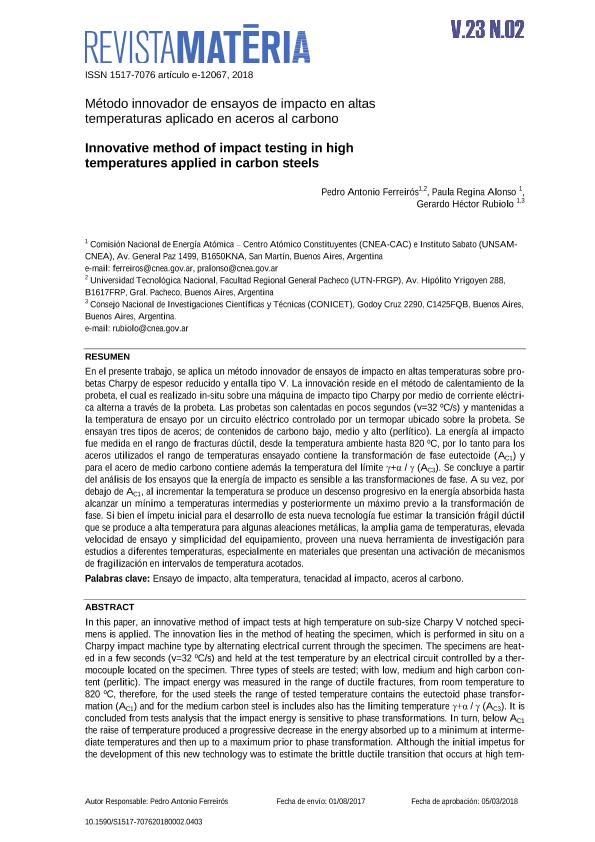Mostrar el registro sencillo del ítem
dc.contributor.author
Ferreirós, Pedro Antonio

dc.contributor.author
Alonso, Paula Regina

dc.contributor.author
Rubiolo, Gerardo Hector

dc.date.available
2020-04-02T18:35:36Z
dc.date.issued
2018-07
dc.identifier.citation
Ferreirós, Pedro Antonio; Alonso, Paula Regina; Rubiolo, Gerardo Hector; Método innovador de ensayos de impacto en altas temperaturas aplicado en aceros al carbono; Universidade Federal do Rio de Janeiro; Matéria; 23; 2; 7-2018; 1-7
dc.identifier.issn
1517-7076
dc.identifier.uri
http://hdl.handle.net/11336/101691
dc.description.abstract
En el presente trabajo, se aplica un método innovador de ensayos de impacto en altas temperaturas sobre probetasCharpy de espesor reducido y entalla tipo V. La innovación reside en el método de calentamiento de laprobeta, el cual es realizado in-situ sobre una máquina de impacto tipo Charpy por medio de corriente eléctricaalterna a través de la probeta. Las probetas son calentadas en pocos segundos (v=32 ºC/s) y mantenidas ala temperatura de ensayo por un circuito eléctrico controlado por un termopar ubicado sobre la probeta. Seensayan tres tipos de aceros; de contenidos de carbono bajo, medio y alto (perlítico). La energía al impactofue medida en el rango de fracturas dúctil, desde la temperatura ambiente hasta 820 ºC, por lo tanto para losaceros utilizados el rango de temperaturas ensayado contiene la transformación de fase eutectoide (AC1) ypara el acero de medio carbono contiene además la temperatura del límite +α / (AC3). Se concluye a partirdel análisis de los ensayos que la energía de impacto es sensible a las transformaciones de fase. A su vez, pordebajo de AC1, al incrementar la temperatura se produce un descenso progresivo en la energía absorbida hastaalcanzar un mínimo a temperaturas intermedias y posteriormente un máximo previo a la transformación defase. Si bien el ímpetu inicial para el desarrollo de esta nueva tecnología fue estimar la transición frágil dúctilque se produce a alta temperatura para algunas aleaciones metálicas, la amplia gama de temperaturas, elevadavelocidad de ensayo y simplicidad del equipamiento, proveen una nueva herramienta de investigación paraestudios a diferentes temperaturas, especialmente en materiales que presentan una activación de mecanismosde fragilización en intervalos de temperatura acotados.
dc.description.abstract
In this paper, an innovative method of impact tests at high temperature on sub-size Charpy V notched specimens is applied. The innovation lies in the method of heating the specimen, which is performed in situ on a Charpy impact machine type by alternating electrical current through the specimen. The specimens are heated in a few seconds (v=32 ºC/s) and held at the test temperature by an electrical circuit controlled by a thermocouple located on the specimen. Three types of steels are tested; with low, medium and high carbon content (perlitic). The impact energy was measured in the range of ductile fractures, from room temperature to 820 ºC, therefore, for the used steels the range of tested temperature contains the eutectoid phase transformation (AC1) and for the medium carbon steel is includes also has the limiting temperature γ+α / γ (AC3). It is concluded from tests analysis that the impact energy is sensitive to phase transformations. In turn, below AC1 the raise of temperature produced a progressive decrease in the energy absorbed up to a minimum at intermediate temperatures and then up to a maximum prior to phase transformation. Although the initial impetus for the development of this new technology was to estimate the brittle ductile transition that occurs at high temperature for some metal alloys, the wide range of temperatures, high test speed and simplicity of equipment, provides a new research tool for studies at different temperatures, especially on materials having embrittlement activation mechanisms at specific temperature intervals.
dc.format
application/pdf
dc.language.iso
spa
dc.publisher
Universidade Federal do Rio de Janeiro

dc.rights
info:eu-repo/semantics/openAccess
dc.rights.uri
https://creativecommons.org/licenses/by-nc-sa/2.5/ar/
dc.subject
ENSAYO DE IMPACTO
dc.subject
ALTA TEMPERATURA
dc.subject
TENACIDAD AL IMPACTO
dc.subject
ACEROS AL CARBONO
dc.subject.classification
Ingeniería de los Materiales

dc.subject.classification
Ingeniería de los Materiales

dc.subject.classification
INGENIERÍAS Y TECNOLOGÍAS

dc.title
Método innovador de ensayos de impacto en altas temperaturas aplicado en aceros al carbono
dc.title
Innovative method of impact testing in high temperatures applied in carbon steels
dc.type
info:eu-repo/semantics/article
dc.type
info:ar-repo/semantics/artículo
dc.type
info:eu-repo/semantics/publishedVersion
dc.date.updated
2020-03-11T13:02:40Z
dc.journal.volume
23
dc.journal.number
2
dc.journal.pagination
1-7
dc.journal.pais
Brasil

dc.description.fil
Fil: Ferreirós, Pedro Antonio. Comisión Nacional de Energía Atómica. Centro Atómico Constituyentes; Argentina. Consejo Nacional de Investigaciones Científicas y Técnicas; Argentina. Universidad Tecnológica Nacional. Facultad Regional General Pacheco; Argentina. Universidad Nacional de San Martín. Instituto Sabato; Argentina
dc.description.fil
Fil: Alonso, Paula Regina. Universidad Nacional de San Martín. Instituto Sabato; Argentina. Comisión Nacional de Energía Atómica. Centro Atómico Constituyentes; Argentina
dc.description.fil
Fil: Rubiolo, Gerardo Hector. Comisión Nacional de Energía Atómica. Centro Atómico Constituyentes; Argentina. Universidad Nacional de San Martín. Instituto Sabato; Argentina. Consejo Nacional de Investigaciones Científicas y Técnicas; Argentina
dc.journal.title
Matéria

dc.relation.alternativeid
info:eu-repo/semantics/altIdentifier/doi/http://dx.doi.org/10.1590/s1517-707620180002.0403
dc.relation.alternativeid
info:eu-repo/semantics/altIdentifier/url/http://ref.scielo.org/6grrxm
Archivos asociados
